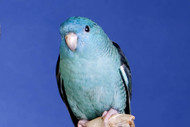Lineolated Parakeet Fact Sheet
Posted by Lineolated Parakeet facts, Parakeet facts, what to feed a Lineolated Parakeet, caring for a Lineolated Parakeet on 9/1/2024
Rosemary Low gives useful information about the Lineolated Parakeet in her blog.
Lineolated Parakeet (Bolborhynchus lineola)
Alternative Name
Barred Parakeet
Similar in size to a Budgie, these are the products that may be suitable for them.
Adult length
16cm (6 ?in)
Adult weight
About 50
Origin
Mexico, Central America the Andes of western South America and as far south as central Peru. It is found mainly between 1,500m and 3,000m but is difficult to detect
Potential lifespan
About 15 years.
Status
Classified as Near-threatened in 1988 but since then status has been revised with the discovery of new populations, especially in Ecuador.
Sexing
Debatable: birds originating from some areas might be sexed by the amount of black in the tail but the sub-species tigrinus (darker and more heavily barred) is apparently not sexually dimorphic and it is likely they have been crossed in aviculture.
Also, the advent of so many mutations makes accurate sexing by plumage even more unlikely. DNA sexing is recommended.
Immature Plumage
The barring is less conspicuous and there is usually a bluer tinge on the forehead in normal (green) birds.
Suitability
The small size and very quiet voice makes the Lineolated Parakeet suitable for any situation. They are ideal beginner?s birds, being easy to care for and not too demanding as companions. Hand-reared birds will enjoy a lot of attention, as do any tame Parrots.
They are also ideal for beginner breeders who cannot keep birds outside. My advice would be to avoid a red-eyed bird such as lutino and cremino for a pet because its eyesight might be slightly impaired. It would be inadvisable to acquire an adult bird as a pet as it would be unlikely to become tame.
Furthermore, it would miss the companionship of other members of its species with which it might have been kept. Consideration might be given to buying two young birds to anyone who is absent from home for most of the day.
Availability
Readily available at an affordable price. Most breeders in the UK (unlike the USA) do not hand-rear their young. However, a parent-reared bird acquired soon after it is independent should become tame if it is given a lot of attention in a stress-free environment. (This means no excitable children or boisterous dogs which can cause stress to any Parrot, but especially very small ones.)
Mutations
These days many mutations are available, similar to those commonly seen in Budgerigars: blue, cobalt, mauve, lutino, cremino, etc.
Behaviour
Lineolated Parakeets move slowly and stealthily along branches, carrying themselves almost horizontally, in a manner which is fascinating to watch. They like to be among leafy branches so an effort should be made to supply these at least once a week. Apple, willow, hazel and elder are suitable.
Don?t be alarmed if you find them sleeping with the head and body pointing downwards. Perhaps this is a quick get-away tactic if they are approached by predators. They are defenceless against other birds and should not be kept with or exposed to other species. They are very gentle and quiet so might not appeal to someone looking for a more extrovert species.
I?m always interested to see what misinformation I can find on the internet, one site was enough. It stated: ?In the wild Lineolated Parakeets are ground feeders and are more inclined to walk than to fly.? Untrue: they feed in the canopy, not on the ground.
Although they sometimes fly low, flocks are also seen flying very high, above the rainforest. Flight is described as direct and very swift.
The same website writer stated that Lineolated Parakeets are not known for their ability to fly and usually fall to the ground if they try to do so. I would suggest there is something very wrong with the management of such birds. They must be overweight and/or kept in small cages where they have insufficient exercise.
It is true that they will climb about and not fly if the cage is too small. Unfortunately, it is the fate of most small species to be kept in cages that are totally inadequate when most small Parrots are more active than large ones.
Browse our excellent choice of Parrot cages here.
Diet
Ideally a mixture of small seeds such as canary, millet and smaller amounts of oats, buckwheat and safflower, sprouted seeds are excellent and add another dimension to the diet. Aviary birds can be given a little hemp. Spray millet and seeding grasses are relished, also seeding dock.
All the usual fruits can be offered but only apple is readily taken by some birds. I found that they like
nectar(as made for Lories), and sponge cake and nectar.
Nectar, or just a mixture of baby cereal with honey water added, is a good base for adding supplements, such as vitamins or calcium, as a mainly seed diet will be deficient in these important components.
Click here for everything a Lineolated Parakeet needs.




